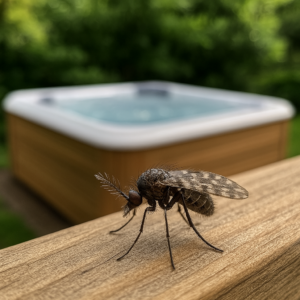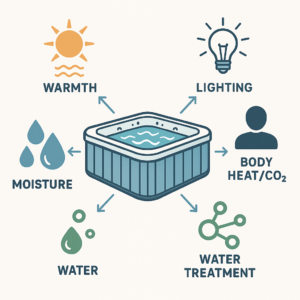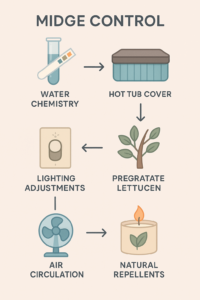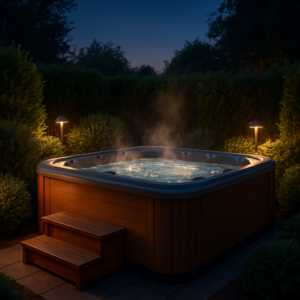Do Hot Tubs Attract Midges? An In-Depth Expert Guide
Discover how midges interact with hot tubs and learn how to keep these tiny insects at bay. In this guide, we explore the science behind midge behavior, the role of hot tub features, and actionable steps to enjoy a midge-free soak.
Introduction
Hot tubs offer relaxation and comfort with their warm water and soothing jets. But many wonder: do hot tubs attract midges? The answer is not black and white. Midges are small insects that live near water. They come in two main types—biting midges and non-biting midges. Biting midges, often called no-see-ums, feed on blood and can be a nuisance. Non-biting midges do not bite but can swarm in large numbers.
Hot tubs may seem like an insect magnet because they release heat, moisture, and light. When people use hot tubs, they also release carbon dioxide and body scents that midges find attractive. Yet, hot tub water is usually treated with chemicals like chlorine or bromine. These chemicals can stop midges from laying eggs in the water. So, the midges you see near a hot tub are more likely drawn by human activity and surrounding nature than the tub itself.
In this post, you will learn:
- The basic biology and behavior of midges.
- How hot tub features like warmth, moisture, and lighting play a role.
- A clear comparison of hot tubs with other water features.
- Step-by-step methods to reduce midge activity.
- Answers to expert questions and practical tips for long-term care.
As you read on, you will find clear tables, diagrams, and key takeaways that simplify complex ideas into easy-to-read segments. Let’s explore the world of midges and how you can enjoy your hot tub without unwanted visitors.

Main Topic Exploration
Understanding Midges
Midges are tiny insects found near water. They come in two groups:
- Biting Midges (No-See-Ums): Tiny and bite, causing irritation.
- Non-Biting Midges: Do not bite but can gather in large numbers.
Midges need water, heat, and moisture to live. They lay eggs in standing water and thrive in humid air. When you use your hot tub, your body heat and CO₂ add extra attractants.
“Insects are very sensitive to CO₂ and heat, which is why they are drawn to human activity around water.”
– Virginia Tech Extension
How Hot Tubs Create a Midge-Friendly Environment
Hot tubs create a microclimate that midges can like. Here are the key points:
- Warmth: Hot water heats the surrounding air. This warmth can signal midges to gather.
- Moisture: Steam and humidity from the hot tub add extra moisture to the air.
- Lighting: Many hot tubs have built-in or surrounding lights. Bright white lights can draw midges at night.
- Human Presence: People in the hot tub release CO₂ and body scents. These cues are strong attractants for biting midges.
- Chemicals: When maintained properly with chlorine or bromine, hot tub water discourages midge breeding. But if maintenance lapses, organic material can build up and attract insects.

The Role of Environment and Maintenance
Even if the hot tub itself is not a breeding ground, the area around it might be. For example, if your hot tub is near gardens or ponds, midges from those areas can wander over. Regular cleaning and proper water treatment are key to reducing insect attraction.
Consider these practical points:
- Location: Hot tubs near natural water bodies or dense vegetation see more midges.
- Season: Midges are more active in warm and humid months.
- Covers: Using a cover when the tub is not in use can keep midges away.
Expert Opinions
Many experts agree that while hot tubs can attract midges, the problem is more about the environment than the tub itself. Maintaining proper water chemistry and cleaning the area can go a long way in reducing midge activity.
“Regular maintenance and careful placement are the best defenses against unwanted insect visitors.”
– Hot Tub Owner HQ
Diagram: Midge Attraction Factors
Comparative Analysis
Hot Tubs vs. Other Water Features
Different water features attract midges to varying degrees. The table below summarizes the differences:
| Feature | Temperature | Water Treatment | Humidity | Midge Attraction |
|---|---|---|---|---|
| Hot Tub | High (warm) | Chemically treated | High | Moderate to high (due to human use) |
| Swimming Pool | Moderate | Chemically treated | Moderate | Low to moderate |
| Natural Pond | Ambient | Untreated | High | High |
Pros and Cons of Hot Tubs for Midge Control
| Aspect | Pros | Cons |
|---|---|---|
| Water Treatment | Disinfects and deters insect breeding | If not maintained, can allow buildup |
| Heat and Moisture | Creates a cozy, relaxing experience | Can also attract insects |
| Lighting | Enhances ambiance | Bright lights may lure midges |
| Human Activity | Enjoyable social setting | CO₂ and scents can invite midges |
This comparison shows that while hot tubs offer many benefits, a few factors can also draw midges. With proper management, you can enjoy your hot tub with minimal insect interference.
Performance Factors
Key Variables Influencing Midge Activity
Several factors work together to influence whether midges appear around your hot tub. These include:
- Water Temperature: Higher temperatures can boost insect activity.
- Humidity Levels: Increased moisture makes the area more inviting.
- Lighting: The type and brightness of lights can affect attraction.
- Chemical Balance: Proper water treatment discourages midge breeding.
- Surrounding Environment: Nearby vegetation and standing water play a role.
- Human Presence: CO₂ and body heat are strong attractants.
Diagram: Interaction of Factors
Optimizing these factors by adjusting light, improving maintenance, and managing the environment can reduce midge interference.
Implementation Guide
Step-by-Step Measures to Keep Midges Away
Follow these steps to create a less inviting environment for midges:
-
Maintain Water Chemistry:
- Test your hot tub water weekly.
- Keep chlorine or bromine levels within the recommended range.
- Shock treat the water monthly to remove organic buildup.
-
Use a Hot Tub Cover:
- Always cover the hot tub when not in use.
- Ensure the cover fits tightly to block insect entry.
-
Adjust Outdoor Lighting:
- Replace bright white lights with yellow or amber bulbs.
- Position lights away from the hot tub area.
- Dim lights after sunset.
-
Improve Air Circulation:
- Place outdoor fans near the hot tub.
- Fans create wind that midges struggle to fly against.
-
Manage Surrounding Vegetation:
- Trim bushes and remove excess plants around the tub.
- Clear any standing water in planters or gutters.
-
Use Natural Repellents:
- Place citronella candles or torches around the area.
- Consider essential oils like eucalyptus or lavender.
-
Install Physical Barriers (if needed):
- Use fine-mesh netting or screens around the hot tub area.
- This prevents midges from landing on the water.
Expert Tip: Regular cleaning and timely water treatment are your best defenses. Even simple steps, when done consistently, can make a big difference.
“A well-maintained hot tub not only offers comfort but also keeps unwanted guests at bay.”
– Hot Tub Owner HQ

Troubleshooting Section
Common Problems and How to Fix Them
If midges still appear despite your efforts, try these troubleshooting tips:
-
Problem: Midge Swarms at Dusk
- Diagnosis: Bright lights attract insects at dawn and dusk.
- Solution: Turn off or dim outdoor lights during peak midge times. Use bug lights instead.
-
Problem: Chemical Imbalance
- Diagnosis: Water treatment is not consistent.
- Solution: Test water frequently. Adjust chemicals as needed and shock treat monthly.
-
Problem: Stagnant Water Around the Hot Tub
- Diagnosis: Standing water in planters or gutters serves as breeding sites.
- Solution: Remove or drain any standing water. Clean gutters and replace saucers under potted plants.
-
Problem: Dense Vegetation Nearby
- Diagnosis: Overgrown plants offer shelter for midges.
- Solution: Trim or relocate vegetation. Consider installing a physical barrier if necessary.
-
Problem: Persistent Midge Activity Despite Measures
- Diagnosis: The local environment may naturally have high midge levels.
- Solution: Use portable fans and natural repellents. For severe cases, consult a pest control professional.
Using a clear checklist and regular inspections will help you catch and fix these issues early.
Innovation and Extended Applications
Exploring New Methods and Trends
New ideas and tools are emerging to keep midges away from hot tubs. Here are some creative approaches:
- Smart Lighting Systems:
- Modern lighting can change color and brightness automatically to deter insects.
- Automated Water Testing Kits:
- These kits can monitor water chemistry in real time and alert you to any imbalances.
- Integrated Repellent Systems:
- Some systems combine fans, repellents, and lighting adjustments to create a unified defense against midges.
- Mobile Apps:
- Apps now help track local midge activity and suggest the best times to use your hot tub.
- Eco-Friendly Repellents:
- Research into plant-based and safe chemical repellents is on the rise. These are effective without harming the environment.
- Community Insights:
- Online forums and social media groups let hot tub owners share tips and new solutions.
By staying open to new ideas, you can improve your midge control strategies. Embracing innovative tools and methods can turn a minor annoyance into a manageable aspect of hot tub ownership.
Long-term Considerations
Sustainable Practices and Ongoing Maintenance
When planning long-term, consider the following:
- Regular Maintenance:
Consistent cleaning and water treatment keep midges away over time. - Upgrade Indicators:
If you notice frequent midge swarms, it may be time to update your maintenance plan or equipment. - Cost-Benefit Analysis:
Investing in new technology (like smart lighting) can reduce pest issues and save money over time. - Environmental Impact:
Use eco-friendly products that protect both your hot tub and the surrounding nature.
A steady, planned approach ensures that your hot tub remains a relaxing retreat for years to come.
Expert FAQ Section
Common Questions Answered
Q1: Do midges come to hot tubs on their own?
A1: No. Midges are mainly drawn by human CO₂, warmth, and surrounding water sources.
Q2: Are non-biting midges a problem?
A2: They can be a nuisance if they swarm, but they do not bite.
Q3: What is the best time to use my hot tub?
A3: Midday is best since midges are most active at dawn and dusk.
Q4: How important is water chemistry?
A4: Very important. Proper chemical levels deter insect breeding in the water.
Q5: Can outdoor fans really help?
A5: Yes. Fans disrupt midge flight and make it hard for them to settle.
Q6: What if I live in a high-midge area?
A6: Combine covers, fans, repellent plants, and regular maintenance to lower their numbers.
Q7: How much extra cost is involved?
A7: Costs vary, but smart upgrades like LED bug lights and automatic water testers are often affordable and save money in the long run.
Key Takeaways
Key Takeaways:
- Hot tubs can attract midges mainly due to heat, moisture, and human presence.
- Regular maintenance and proper water treatment are crucial.
- Adjusting lighting and improving air circulation can greatly reduce midge activity.
- Environmental management, such as trimming nearby vegetation and eliminating standing water, plays a key role.
- Innovative tools and smart systems offer new ways to tackle midge issues.
Glossary
- Aeration: The process of adding air to water to improve quality.
- Bromine: A chemical used to sanitize hot tub water.
- Chlorine: A disinfectant used to treat water in hot tubs and pools.
- CO₂ (Carbon Dioxide): A gas exhaled by humans that attracts midges.
- Chemically Treated: Water that has been sanitized with chemicals.
- Humidity: The amount of water vapor present in the air.
- Midge: A small flying insect, either biting or non-biting.
- No-See-Ums: A nickname for biting midges due to their small size.
- Phototaxis: The movement of an organism toward or away from a light source.
- Repellent: A substance used to keep insects away.
Conclusion
Hot tubs do have factors that attract midges, but the insects are mainly drawn by human activity and surrounding environmental conditions. By understanding the role of warmth, moisture, light, and chemical balance, you can take clear steps to reduce midge presence.
Remember:
- Maintain proper water chemistry.
- Use covers and adjust lighting.
- Improve air circulation and manage your environment.
These strategies not only keep your hot tub clean but also ensure a peaceful, insect-free experience. Enjoy your hot tub and take control of your outdoor space with these expert tips.
For more tips and in-depth advice, explore trusted hot tub maintenance sites and join online forums where experts share the latest updates.
Additional Resources:
- Hot Tub Owner HQ
- Virginia Tech Extension Publications
- Local Pest Control Forums
- Water Chemistry Guides for Pools & Hot Tubs
Feel free to share your thoughts or ask questions below. Your feedback helps us refine and improve future posts!

